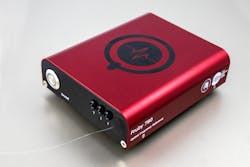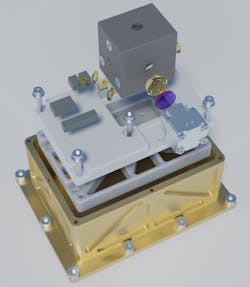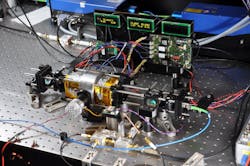Optical frequency reference within the palm of your hand
It’s a kind of “old” quantum technology: A semiconductor laser locked to the D2 transition of rubidium. As an optical frequency reference, it may pave the way for several new (quantum) technologies such as optical clocks or quantum sensors. Because the system is small and rugged, it may find use in mobile systems on the ground or in space (see Fig. 1).
It was developed in the Joint Lab Integrated Quantum Sensors of the Ferdinand-Braun-Institut (FBH) and Humboldt-Universität zu Berlin (both in Berlin, Germany).
“A clock consists of two essential parts: an oscillator and a clockwork to convert the oscillations into time,” says Julien Kluge, a Ph.D. student in the Joint Lab. “The higher the oscillator frequency, the more precise the clock can become. So, we’re working on an optical oscillator at roughly 385 THz. This is far beyond the current standard for clocks on GPS satellites, which typically use references in the microwave (GHz) region.”
An ultrastable optical oscillator locked to a certain atomic transition is an atomic optical frequency reference (AOFR), which the team in Berlin presented recently in a paper in Optics Express.1 The development evolved from more than a decade of research on cold-atom-based quantum sensors, in which the AOFR is a critical subsystem. Other use cases for AOFRs, mentioned in the study, are the calibration of optical instruments or absolute referencing of laser systems in quantum technology applications for trace-gas detection or optical communication.
Small is beautiful
Several different architectures were demonstrated to accomplish a frequency standard, all of which deal with the tradeoff between precision and size. Radio-frequency atomic clocks, for example, can be purchased off-the-shelf and are already flying on the current generation of GALILEO GPS satellites along with hydrogen masers (which send hydrogen gas through a magnetic gate, and only allow atoms in certain energy states to pass through).
Future optical atomic beam frequency standards that fit within a few shoeboxes can reach 10-16 per second, but require a more-sophisticated spectroscopy setup and additional lasers to manipulate and detect the atoms. Lab-sized systems based on trapped and cooled atoms or ions allow for precision down to 10-18 per second, which is several orders of magnitude more stable than currently needed for applications such as GPS satellites.
The researchers targeted a solution suited for plug-and-play lab operation that could be advanced for space applications; that is, small, maintenance-free, and has low energy consumption.
They’re focusing on experiments with cold and warm atoms, where the rubidium D2 line is a common standard. Accordingly, they built the AOFR around a rubidium vapor cell. The vapor cell is integrated into an optical module with a DFB laser diode and a detector for frequency modulation spectroscopy of the D2 line at 780 nm. These components are temperature-stabilized, and the optics module is described in another paper in JOSA B2 as occupying a volume of 35 cm3, weighing 73 g, and consuming 780 mW of power.
The optics module is complemented by a control and lock-in amplification unit, a temperature controller, and a current driver. Its lock-in amplifier is driven by using a field-programmable gate array-based tool for automated frequency locking described in Review of Scientific Instruments.3
The system is designed for passive cooling at room temperature, and it takes about two minutes for the laser to be automatically locked after a cold start. Its output signal of about 6 mW is provided via a standard single-mode polarization-maintaining fiber.
Relative frequency instability was measured to be 1.4 × 10-12 at 1 s, and below 10-11 at 105 s averaging time. At 100 s averaging time, the stability reaches a minimum of 4 × 10-13.
“In the end, we are limited by the linewidth of the D2 line,” explains Kluge. So, they’re working on frequency standards with improved longer-term stabilities than those of the prototype. This is highly relevant to optical clock applications for navigation, in which 10-13 in one second is the “sweet spot.”
Kluge and colleagues are developing a system with that stability in a 2-liter volume, at a weight of less than 2 kg, with a 10 W power requirement. This project (named CRONOS) aims to take this knowledge and technology and apply it to build a reference based on the 5S-5D two-photon transition in rubidium (see Fig. 2). It has already been successfully demonstrated within a laboratory setup with a leading short-term instability of 1.5 × 10-13.Current efforts are focusing on miniaturization and integration targeting a reference with the above-mentioned SWaP budget. Laser systems are developed at FBH to fit alongside the reference and provide a turnkey system for micro-satellite missions in the coming years.
The optical frequency reference as presented by the researchers shows how far integrated laser technology can be pushed to create a palm-sized system with a stability of 10-12 in 1 sec. And the next system generation is already in development. With a slightly different rubidium transition, it will offer a precision of 10-13 from the same footprint (see Fig. 3).Turnkey and palm-sized optical frequency standards will have numerous applications, starting with cold-atom quantum experiments. They can be adapted to different wavelengths using other atomic species or transitions. Size and a long lifetime may make it a plug-and-play component for precision clocks and various kinds of quantum sensors on the ground or in space where a maintenance-free operation over years is important.
REFERENCES
1. A. Strangfeld et al., Opt. Express (2022); https://doi.org/10.1364/oe.453942.
2. A. Strangfeld et al., JOSA B, 38, 6 (2021); https://doi.org/10.1364/josab.420875.
3. B. Wiegand et al., Rev. Sci. Instrum., 93, 063001 (2022); https://doi.org/10.1063/5.0090384.
About the Author
Andreas Thoss
Contributing Editor, Germany
Andreas Thoss is the Managing Director of THOSS Media (Berlin) and has many years of experience in photonics-related research, publishing, marketing, and public relations. He worked with John Wiley & Sons until 2010, when he founded THOSS Media. In 2012, he founded the scientific journal Advanced Optical Technologies. His university research focused on ultrashort and ultra-intense laser pulses, and he holds several patents.
Julien Kluge
Ph.D. Student
Julien Kluge is a Ph.D. student in the Joint Lab Integrated Quantum Sensors at Ferdinand-Braun-Institut and Humboldt-Universität zu Berlin (Berlin, Germany).
Markus Krutzik
Group Leader, Optical Metrology Group at Humboldt-Universität zu Berlin
Markus Krutzik is a group leader of the Optical Metrology Group at Humboldt-Universität zu Berlin (Berlin, Germany).



